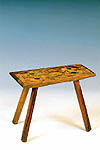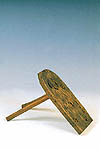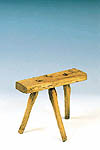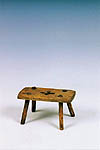 |
|
Ethnography became intensively interested in the correlations
between objects and their use, and objects and their meanings during the
past few decades. These concepts were only followed by the increase of
the collection to a small extent. In these cases, upon selecting objects,
collectors aim at exhibiting the expressions of a lifestyle, a cultural
sample or a national feeling with the help of the objects. Chairs exhibited
in the hall that are apparently all have the same form used to mean different
things to their owners. Each of them has a different function: small chair
for milking, small chair for shelling, small chair to recognize the witches,
etc.
„The chair is named on the basis of the size of the different
parts and also on the basis of its function or use. According to nomination
based on the size the chair can be a kisszék, hosszúszék or magosszék.
The kisszék has short seat board (32 cm) and short legs (25 cm); the hosszúszék
has long seat board (from 40 to 500 cm even) and short legs; while the
magosszék has long seat board (45 cm) and long legs (45 cm).
On the basis of their function these chairs can be furnished
with new names. Thus the kisszék can be a fejőszék, lucaszék, or in other
application: a kisszék; the long chair can be a ringő, vízszék or simply
a hosszúszék; while the magosszék is: mosószék, ácsszékláb or magosszék.”
„The small chair to the spinningroom was fabricated by
the fellow to its lover…”
Csilléry Klára: A maconkai szék. [The Chair of Maconka.]
Ethnographia LIX(1–4). 1948, 149. p.
For more information click on the pictures! |



